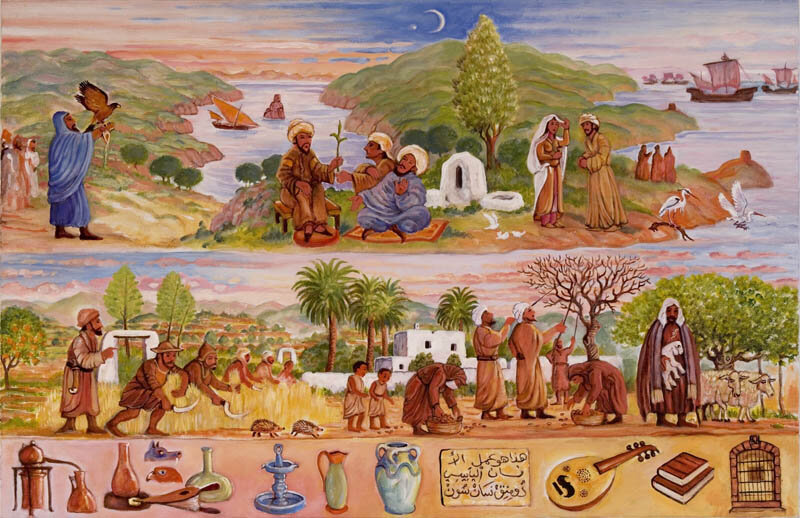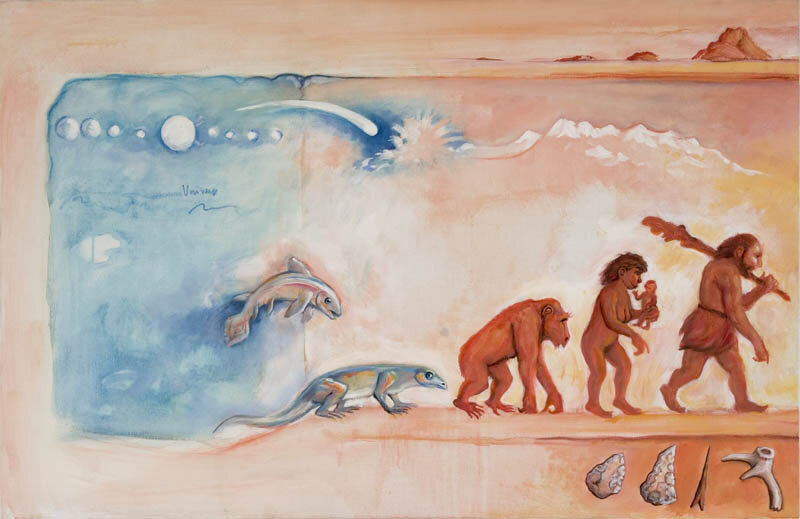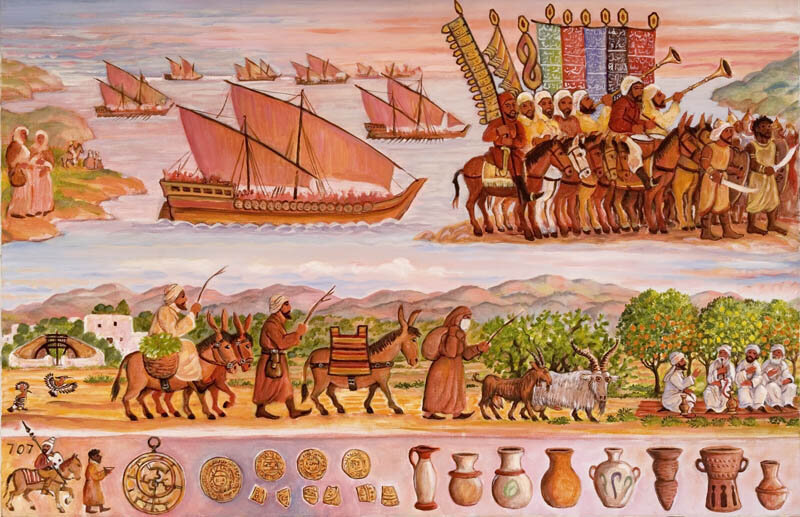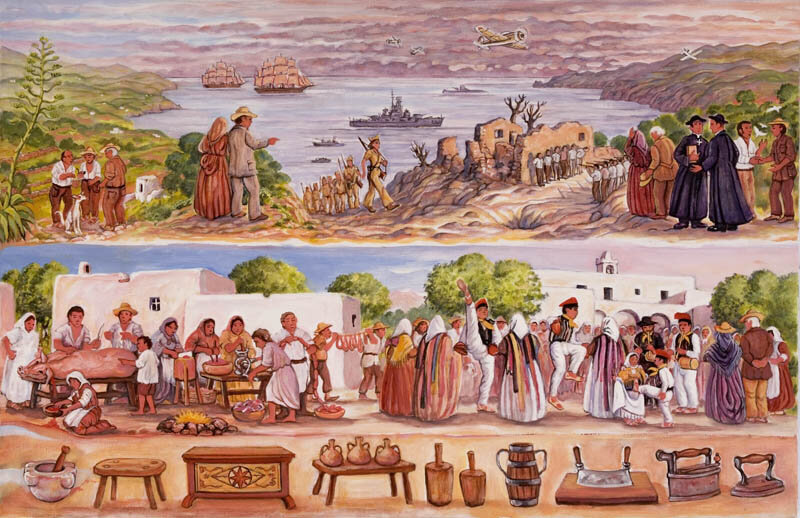
The History of Ibiza and Formentera
Painted by Dominique Sanson on 20 canvases (1m x 0.65cm), this series of original paintings in oil & acrylic paint, join together to form a flowing sequence of historical events.
It depicts life from pre-history to current day, the arrival of Phoenicians, Greeks, Romans, Carthaginians, Muslims, Catalans, etc to modern day visitors. Architecture, artifacts, coins, costumes, deities, flora & fauna, culture and traditions are also shown.
Interest is enthusiastic from people of all backgrounds, ages and nationalities and has been praised by historians, intellectuals, politicians, residents & tourists.
This original artwork which took over 2 years to research and paint shows Dominique´s passion for Ibiza and dedication to preserving its history and culture for future generations.
Karen Worrall, aka Cruise Ship Karen is a freelance destination enrichment speaker and travel writer. This video is taken from a talk that she gave on a cruise ship.
Click on the picture to start the video.
I EVOLUTION You can see the solar system and a comet exploding in the atmosphere. The Earth has taken shape. A Saurian emerges from primeval waters. A primate, a primitive man and woman walk towards the future.
II PREHISTORY Around 5000BC: Neolithic people migrate from the Iberian Peninsula. Life was difficult as there were only sea mammals, fish and birds to hunt. At the end of the Copper Age around 1800 BC a new population arrives. People dwell in caves and huts, practicing basic agriculture and raise sheep and goats.
III THE PHOENICIANS Intrepid seamen from Tyre and other city states trade with the Pitiusas. Phoenicians trade salt, wine, olive oil, vegetables, wood, weapons, gold, silver, tin, lead and crystal ware. They also bring purpura dyed material, grapes, figs, pomegranates and citric fruit. The Ibicenco hound is introduced to the Baleares.
IV VISITS OF THE GREEKS Greeks traded with Ibiza and Formentera naming them ‘the Pitiusas’ because of all the pine trees. Legend says Ulysses sailed near Es Vedra. The Greeks exchange wine and bronze weapons for salt, salted fish and fresh vegetables. The islanders are famous slingers, using the ‘basetja’ for hunting and war.
V CARTHAGINIANS AND ROMANS Carthage controls trade in The Mediterranean and by 654 B.C. and the island population is basically Carthaginian. Hannibal hires Ibicencan slingers to fight the Roman legions. You can see the Punic Wars with elephants and Roman war machines. A treaty is signed and Ibiza becomes a Roman city, named ‘Ebusus’.
VI ROMANS AND CARTHAGINIANS I The island population is now under Roman Rule and people are worshipping Roman and Carthaginian gods and using coins of both cultures. Nearby Santa Eulalia bridge people are bathing. Agriculture is more refined with wells and irrigation systems. Young men collect grapes.
VII ROMANS AND CARTHAGINIANS II Refinement is now accessible. We can see musicians, dancers, teachers and courting. Young men tread grapes to make wine which is stored in the amphorae and loaded onto Roman trade ships.
VIII THE VANDALS When the Roman Empire collapses it is divided into two parts. The Western part is invaded by Germanic tribes. One such group the Vandals were evicted from Iberia by the Visigoths and moved to Tunis where they took control of the Pitiusas. Looting, destroying, raping and pillaging the locals, the Vandals didn’t leave much behind culturally.
VIV BYZANCE Constantinople, now Istanbul becomes the most important city in the Mediterranean and Justinian defeats the Vandal Empire, capturing Ibiza in 535 A.D. Bishops and priests arrive and convert the population. Scholars discuss the essence of Jesus Christ. In the countryside life goes on as usual.
X THE MOORS I In 707 A.D., captain ABD Allah Ibn Musk raids the Balearic’s with his fleet. Islanders feel the Arab influence and from 902 A.D. onwards are integrated into their civilization over a long period of tolerance and prosperity. Arabs bring improvements in agriculture and irrigation.
XI THE MOORS II Ibosim (Ibiza) and Formentera are under Muslim influence, culture and technology. The land is very productive, with ‘Feixes’, almond picking and sheep. Below are an alembic for distillation, athanor for Alchemy, a small ceramic fountain and vases, books and a musical instrument. On the right is the Portal of San Ciriaco where the Catalan and Aragones conquerors entered old Ibiza town.
XII THE CATALANS I In 1234 A.D. the archbishop of Tarragona, Guillerm de Montgri conquers Ibiza, together with Don Pedro de Portugal and Don Nuno Sanz, 12th of April, 12.
XIII THE CATALANS II The Arabs leave the island, the Catalan army celebrates and Ibiza is divided into three regions along the lines of the previous Moorish divisions. Christianity returns. Peasants are ploughing the fields, sheep shearing and wool gathering.
XIV THE CATALANS III A local market situated near a defence tower. The Pitiusas islands are subject to piracy from North African Moors and other Mediterranean invaders. Preparing garlic strings, figs are cut in half and ‘frigola’ added. A Peasant blowing a conch shell and a ginette watches a robin and a wagtail.
XV SOCIAL LIFE Christian customs and religion are established and a few churches are built. Christopher Columbus who might have been Ibicenco is selling his projects of discovery to the Catholic Kings, Ferdinand of Aragon and Isabel of Castille. Mules are treading the corn grain on an ‘aria’. Peasants sort the grain observed by city merchants. Bread is being baked in a typical bread oven.
XVI THE CORSAIRS Ibiza is attacked frequently by pirates from the Ottoman Empire. A group of Ibicenco Corsairs, showing their Corso licence are talking, while keeping watch onTurkish prisoners. A group of smugglers disembark with tobacco and alcohol. Boat building of yauts, jabekes and Galleys flourish.
XVII WAR OF SUCCESSION King Carlos II passes the crown of Spain to Philippe, Duque de Anjou. But in 1706 the Archduke of Austria sends in an Anglo-Dutch fleet to submit the island. The local government known as ‘the University’ agrees. The Bishop Abad y Lasierra brings reforms encouraging peasants to plant fruit and nut trees and promoting construction of seven churches. Fishermen talk and two peasants collect seaweed for roof insulation and carob harvesting.
XVIII THE CIVIL WAR In 1936 the Civil War starts. Ibiza and Formentera are subject to tragic episodes by both the Nationals and the Republicans. Hundreds of people are shot. In the lower centre there is a ‘matanza’ for the annual killing of a fattened pig to make ‘sobrasada’ and ‘butifara’. Typical ‘Baile Pages’ with traditional costumes and music.
XIX THE ARRIVAL OF TOURISM It is a time of reconstruction and renovation of fincas. The building of hotels for tourism changes the economy. ‘Es Camio’, the old bus from Ibiza to Santa Eulalia, hippies arrive and are welcomed by an elderly Ibicenca lady. Hunters, workmen at the Salinas salt flats and train that carried salt to the harbour. The Guardia Civil are watching tourists bathing nude to give them a fine.
XX MODERN TIMES There is hippy market where tourists gather for handicraft and jewellery. Lots of people are going towards a far beach with Es Vedra in the distance. There is a celebration of the full moon with drummers, dancers and hippies having a good time. The future of Ibiza and Formentera is now tied to the influence of the world at large. Let us hope for the best.



















